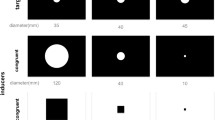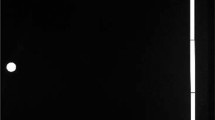Abstract
Over the past decade there has been a great deal of controversy regarding the relative impact of visual illusions on cognitive judgments and the control of goal-directed action. We report the results of two experiments indicating that perceptual biases associated with the Müller-Lyer illusion involve a misjudgment of amplitude/extent while aiming biases involve error in the specification of a movement endpoint. This dissociation of perception and action is consistent with some aspects of Milner and Goodale’s two visual system model, but not others.






Similar content being viewed by others
Notes
Binsted and colleagues (Binsted and Elliott 1999a; Binsted et al. 2001) demonstrated that both eye and open-loop hand movements are biased by M-L configurations in which tails were present at only the target end of the figure. It appears that when visual information about the position of the hand is not available during movement execution, extraretinal information about the position and movement of the eyes contributes to manual aiming bias.
Catching a moving object, such as a ball, depends partly on our ability to perceive the expansion of the ball’s texture elements relative to the elements in the visual background and to regulate a hand movement accordingly (Elliott and Meegan 2004).
One could argue that always starting the movement at the left vertex of a configuration would lead participants to adopt an end position strategy (i.e., simply ignore the left vertex). However, it was also the case that target lines and comparison lines always originated at the left vertex in the perceptual protocol. Thus, perceptual judgments could have been made based only on the endpoint of the target and comparison shafts. This was not the case.
Tremblay and Elliott (2003) have shown that cognitive vs. motor decision-making influences the magnitude of vestibular bias on judgments of the visual straight-ahead in the absence of any visual context (i.e., a completely dark room).
References
Aglioti S, Goodale MA, DeSouza JFX (1995) Size-contrast illusions deceive the eye but not the hand. Curr Biol 5:679–685
Binsted G, Elliott D (1999a) Ocular perturbations and retinal/extraretinal information: the coordination of saccadic and manual movements. Exp Brain Res 127:193–206
Binsted G, Elliott D (1999b) The Müller-Lyer illusion as a perturbation to the saccadic system. Hum Mov Sci 18:103–117
Binsted G, Elliott D, Helsen W, Chua R (2001) Eye-hand coordination in goal-directed aiming. Hum Mov Sci 20:563–585
Brenner E, Smeets JBJ (1996) Size illusion influences how we lift but not how we grasp an object. Exp Brain Res 111:473–476
Burnod Y, Baraduc, P, Battaglia-Mayer, A, Guigon, E, Koechlin, E, Ferraina, S, Lacquaniti, F, Caminiti, R (1999) Parieto-frontal coding of reaching: an integrated framework. Exp Brain Res 129:325–346
Carey DP, Harvey M, Milner AD (1996) Visuomotor sensitivity for shape and orientation in a patient with visual form agnosia. Neuropsychologia 34:329–337
Chua R, Elliott D (1993) Visual regulation of manual aiming. Hum Mov Sci 12:365–401
Donkelaar P van (1999) Pointing movements are affected by size-contrast illusions. Exp Brain Res 125:517–520
Elliott D (1992) Intermittent vs. continuous control of manual aiming movements. In: Proteau L, Elliott D (eds) Vision and motor control. Advances in psychology series. North Holland, Amsterdam, pp 33–48
Elliott D, Lee T (1995) The role of target information on manual aiming bias. Psychol Res 58:2–9
Elliott D, Madalena J (1987) The influence of premovement visual information on manual aiming. Q J Exp Psychol A 39:541–559
Elliott D, Meegan DV (2004) Visual context can influence on-line control. Behav Brain Sci (in press)
Elliott D, Helsen WF, Chua R (2001) A century later: Woodworth’s two-component model of goal-directed aiming. Psychol Bull 127:342–357
Elliott D, Hansen S, Mendoza J, Tremblay L (2004) Learning to optimize speed, accuracy and energy expenditure: a preliminary framework for understanding speed-accuracy relations in target-directed aiming. J Mot Behav (in press)
Feldman AG (1966) Functional tuning of the nervous system with control of movement or maintenance of a steady posture. II. Controllable parameters of the muscles. Biophysik 11:667–675
Franz VH (2001) Action does not resist visual illusions. Trends Cogn Sci 5:457–459
Franz VH, Gegenfurtner KR, Bulthoff HH, Fahle M (2000) Grasping illusions: no evidence for a dissociation between perception and action. Psychol Sci 11:20–25
Gentilucci M, Chieffi S, Deprati E, Saetti MC, Toni I (1996) Visual illusion and action. Neuropsychologia 34:369–376
Gillam B, Chambers D (1985) Size and position are incongruous: measurements on the Müller-Lyer figure. Percept Psychophys 37:549–556
Glover SR, Dixon P (2001) Dynamic illusion effects in a reaching task: evidence for separate visual representations in the planning and the control of reaching. J Exp Psychol Hum Percept Perform 27:560–572
Judd CH (1898) An optical illusion. Psychol Rev 5:286–294
Judd CH (1905) The Müller-Lyer illusion. Psychol Monogr 7 [Suppl 29]:55–82
Laabs GJ (1973) Retention characteristics of different reproduction cues in motor short-term memory. J Exp Psychol 100:168–177
Mack A, Heuer F, Villardi K, Chambers D (1985) The dissociation of position and extent. Percept Psychophys 37:335–344
Meegan DV, Glazebrook CM, Dhillon VP, Tremblay L, Welsh TN, Elliott D (2004) Directing actions at visual illusions: planning, control and memory. Exp Brain Res 155:37–47
Milner AD, Goodale MA (1995) The visual brain in action. Oxford University Press, Oxford
Norman J (2002) Two visual systems and two theories of perception: an attempt to reconcile the constructivist and ecological approaches. Behav Brain Sci 25:73–96
Pavani F, Boscagli I, Benvenuti F, Rabuffetti M, Farne A (1999) Are perception and action affected differently by the Titchner circles illusion? Exp Brain Res 127:95–101
Pepper RL, Herman LM (1970) Decay and interference effects in the short-term retention of a discrete motor act. J Exp Psychol 83:1–18
Post RB, Welch RB (1996) Is there dissociation for perceptual and motor responses to figural illusion? Perception 25:569–581
Proteau L, Masson G (1997) Visual perception modifies goal directed movement control: supporting evidence from visual perturbation paradigm. Q J Exp Psychol A 50:726–741
Rosenbaum DA, Loukopoulos LD, Meulenbroek RGJ, Vaughan J, Engelbrecht SE (1995) Planning reaches by evaluating stored postures. Psychol Rev 102:28–67
Salinas, E, Abbott, L (1995) Transfer of coded information from sensory networks. J Neurosci 15:6461–6474
Schmidt RA, Lee TD (1999) Motor control and learning: a behavioral emphasis. Human Kinetics, Champaign
Sternberg S (1969) The discovery of processing stages: extensions of Donders’ method. In: Koster WC (ed) Attention and performance II. North Holland, Amsterdam
Tanaka K (1993) Neuronal mechanisms of object recognition. Science 262:685–688
Tremblay L, Elliott D (2003) Contribution of action to perception of self orientation. Neurosci Lett 349:99–102
Westwood DA, Goodale MA (2003) Perceptual illusion and the real-time control of action. Spat Vis 16:243–254
Author information
Authors and Affiliations
Corresponding author
Additional information
This research was supported by the Natural Sciences and Engineering Research Council of Canada and the Canada Research Chairs Programme
Rights and permissions
About this article
Cite this article
Glazebrook, C.M., Dhillon, V.P., Keetch, K.M. et al. Perception-action and the Müller-Lyer illusion: amplitude or endpoint bias?. Exp Brain Res 160, 71–78 (2005). https://doi.org/10.1007/s00221-004-1986-y
Received:
Accepted:
Published:
Issue Date:
DOI: https://doi.org/10.1007/s00221-004-1986-y




